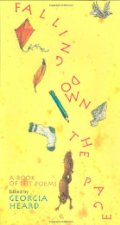PreK 3 through grade 2: Guiding Questions - What is poetry? What is rhyme?
 |
| Collage by PhotoVisi |
We talked about vowel sounds in the middle of words, consonants at the end, complete rhyme (cat/bat), and weak rhyme (horrid/forehead).
PreK and K read some fun Jez Alborough stories with lots of complete rhymes. Grade 1 and 2 heard some more complex rhymes.
Sing a Song of Popcorn, edited by Beatrice Schenk De Regniers, is a wonderful anthology of children's poems, and includes one of my personal favorites: Ogden Nash's "Adventures of Isabel" a girl-power story poem.
R is for Rhyme, by Judy Young, is an alphabet book with each letter explaining a different poetry concept or form. We read "How Would You Act?" on the E is for End rhyme page. There's a teacher's guide for the book here.
Duck in the Truck and Fix-It Duck, by Jez Alborough are both funny stories full of complete rhymes.
Grade 3: Guiding Question - What are "concrete" poems?
We kicked off poetry month with a look a concrete or "shape" poems. This year, one of our Silver Knight books is A Dazzling Display of Dogs, by Betsy Franco and illustrated by Michael Wertz. I reviewed it a while back here.
After reading a few from this collection of concrete poems, we came up with a definition for this type of poem, and then tried some of our own. Students created their own shapes and filled them in with related words. There's also a fun online concrete poem generator via Read.Write.Think on the grade 3 page of the library website.
Grade 4: Guiding Questions - What are "List" poems? How can we show emotions with words?
We talked about poems that list words and phrases that combine to create an emotion. We used Falling Down the Page, edited by Georgia Heard to hear some examples. This collection of list poems includes funny ones like "In My Desk", by Jane Yolen, and more serious moody ones, like --
Next, students looked at an image (using SlideShare below) and tried to list whatever words came to mind; we tried to write fast, letting the words spill down the page. We repeated this with three more images, each time sharing our results and gradually warming up to have longer and longer lists of ideas.
Back in the classroom, students and their teachers can view the images again and choose one picture to spend more time with, following steps for revision to shape the listed words into a meaningful poem.
See images and revision steps in this SlideShare. It includes direction for using PicLits, which we'll play with next week.
Grade 5 - Check out only
Next week: Spine label poems!



No comments:
Post a Comment